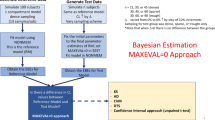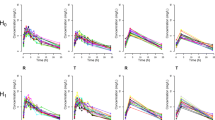Abstract
Purpose. This paper investigated the influence of critical design factors on the power of a population pharmacokinetic (PK) study for identifying subpopulations that have different drug clearance than the typical population.
Methods. A study simulation approach was used for the power estimation. The design factors included the number of subjects, sampling scheme, and compliance.
Results. The false positive rates of incorrectly identifying a subpopulation were estimated for several scenarios. The false positive rates of the population PK study was relatively low, except when the numbers of subjects with full profiles and the subjects with troughs were distributed between populations in an unbalanced manner. The total number of subjects did not seem to have as much influence on study power as the number of subjects in the subpopulation, as long as the total number of subjects was significantly larger than the subpopulation. The variability of sampling time played an important role in both the statistical power and the accuracy of the estimated difference in clearance. Taking three samples provided greater power and better accuracy than taking two samples per subject. Taking only trough samples provided little power and poor estimation of clearance difference. Adding subjects with full profiles to a study with only trough samples taken in other subjects did not satisfactorily improve the clearance estimation. It was critical to account for dosing record in the population PK analysis to achieve appropriate power and accuracy. If the variability in dosing time was accounted for in the analysis, it improved the accuracy of the estimated difference in clearance. Missing dose administrations reduced the study power and resulted in deviation of estimated clearance difference.
Conclusions. The power of a study should be determined prospectively to ensure appropriate study design for specific study objectives.
Similar content being viewed by others
REFERENCES
E. I. Ette, C. A. Howie, A. W. Kelman, and B. Whiting. Experimental design and efficient parameter estimation in preclinical pharmacokinetics studies. Pharm. Res. 12:729-737 (1995).
E. I. Ette, A. W. Kelman, C. A. Howie, and B. Whiting. Influence of inter-animal variability on the estimation of population pharmacokinetic parameters in preclinical studies. Clin. Research & Reg Affairs 11:121-139 (1994).
E. I. Ette, A. W. Kelman, C. A. Howie, and B. Whiting. Analysis of animal pharmacokinetic data: performance of the one point per animal design. J. Pharmacokinet. Biopharm. 23:551-566 (1995).
H. Sun, E. I. Ette, and T. M. Lundden. On the recording of sample times and parameter estimation from repeated measures pharmacokinetic data. J. Pharmacokinet. Biopharm. 24:637-650 (1996).
P. Girard, L. B. Sheiner, H. Kastrissios, and T. F. Blaschke. Do we need full compliance data for population pharmacokinetic analysis? J. Pharmacokinet. Biopharm. 24:265-282 (1996).
D. B. White, C. A. Walawander, D. Y. Liu, and T. H. Grasela. Evaluation of hypothesis testing for comparing two populations using NONMEM analysis. J. Pharmacokinet. Biopharm. 20:295-313 (1992).
Author information
Authors and Affiliations
Rights and permissions
About this article
Cite this article
Lee, P.I.D. Design and Power of A Population Pharmacokinetic Study. Pharm Res 18, 75–82 (2001). https://doi.org/10.1023/A:1011030827847
Issue Date:
DOI: https://doi.org/10.1023/A:1011030827847




